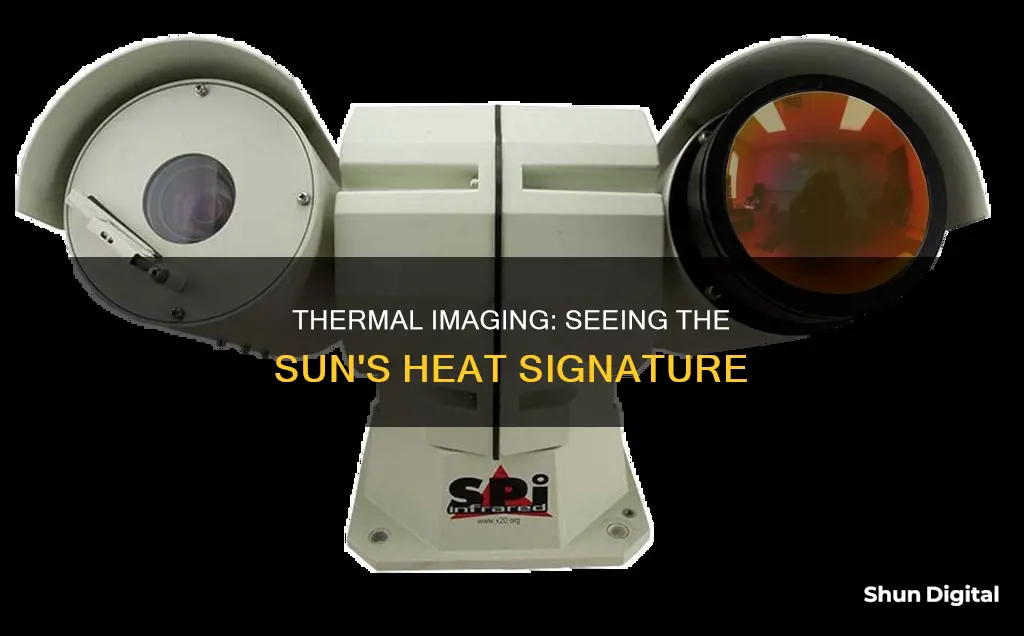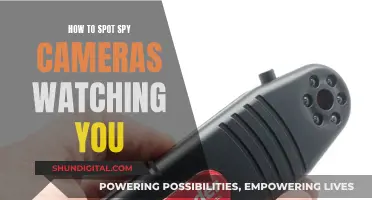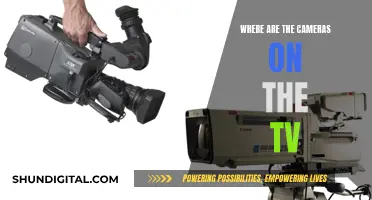
Thermal imaging is a technique that uses infrared technology to detect and visualise variations in temperature. All objects emit thermal energy, which can be captured and represented as a thermal image. Thermal cameras detect and measure the infrared energy emitted by objects and convert it into an image that highlights temperature differences. This allows thermal cameras to see in complete darkness or smoke-filled environments. However, their ability to see through certain materials, such as walls, concrete, and glass, is limited. While thermal imaging has various applications, from building inspections to firefighting, it is important to understand its limitations when trying to observe extremely hot objects like the sun.
| Characteristics | Values |
|---|---|
| How does it work? | Thermal cameras detect and convert infrared energy (heat) into a visual image. |
| Comparison to regular cameras | Regular cameras and the human eye work on the principle of visible light energy bouncing off objects. |
| What they detect | Heat sensed by a thermal camera can be measured precisely, allowing for a large variety of applications. |
| What they're used for | Thermal cameras are used for surveillance, military operations, building inspections, firefighting, autonomous vehicles, skin temperature screening, industrial inspections, and scientific research. |
| Effectiveness in different conditions | Thermal cameras can see in total darkness, through light fog, light rain, and snow, but the distance they can see is affected by these conditions. |
What You'll Learn

How does a thermal camera work?
Thermal cameras, also known as infrared cameras, work by detecting and measuring the heat emitted by objects and their surroundings. This process is called thermography.
All objects emit heat, officially known as infrared energy or thermal energy, in the form of electromagnetic radiation. The hotter an object, the more thermal energy it emits. Thermal cameras are equipped with special lenses that can detect this infrared radiation. The lens of a thermal camera is not made of glass, as glass blocks the long-wave infrared radiation (LWIR) frequencies that are most useful for thermography. Instead, lenses are usually made of germanium, zinc selenide, calcium fluoride, or sapphire.
The infrared radiation passes through the lens and is then captured by an array of sensors or a detector chip, which contains thousands of pixels that react to the infrared energy focused on them. The camera's processor then takes the signals from the pixels and applies a mathematical calculation to create a colour map of the apparent temperature of the object. Each temperature value is assigned a different colour. The resulting matrix of colours is sent to the camera's memory and display as a thermal image.
Thermal cameras are used in a wide range of applications, including industrial inspections, building maintenance, security and surveillance, medical inspections, and astronomy. They are particularly useful for detecting temperature anomalies, such as overheating machinery or electrical circuits, which can help prevent equipment failures and enhance safety.
Smart TV Camera Eye: Where is it?
You may want to see also

What is thermal imaging used for?
Thermal imaging is a versatile technology with a wide range of applications across various sectors. Here are some of the key uses of thermal imaging:
Industrial and Manufacturing Applications
Thermal imaging plays a crucial role in preventive maintenance and safety in industrial settings. By detecting abnormal heat patterns, such as overheating machinery or electrical circuits, thermal cameras can help prevent equipment failures and enhance operational efficiency. Thermal imagers are also used to identify insulation failures, moisture issues, and other potential problems that may be invisible to the naked eye.
Building Maintenance and Construction
In the construction and building maintenance industries, thermal imaging is used to detect heat loss, poor insulation, and water leaks. This makes it an essential tool for energy audits, building inspections, and identifying structural defects.
Medical and Veterinary Fields
Thermal imaging cameras can aid in the early detection of certain medical conditions by detecting changes in body temperature. For example, they are used in the early detection of breast cancer. In veterinary medicine, thermal imaging can help diagnose disorders associated with the neck, back, limbs, and circulatory problems.
Security and Surveillance
Thermal imagers are commonly used in security and surveillance operations. They can detect heat signatures, making it possible to identify people or animals in low-light or dark conditions. This technology is valuable for law enforcement agencies during search and rescue operations, crime scene investigations, and locating suspects, especially at night.
Firefighting and Emergency Services
Firefighters use thermal imaging to see through smoke during rescue missions and to rapidly identify spot fires. Thermal cameras also assist in locating survivors during firefighting operations by detecting human or animal presence.
Transport and Navigation
Thermal imaging is beneficial for transport navigation, especially at night or in low-visibility conditions. For example, maritime navigation uses thermal imaging to detect other vessels, people, and obstructions during night sailing or in severe weather. Infrared cameras are also now being incorporated into cars to alert drivers to people or animals beyond streetlights or headlights.
Pest and Animal Management
Thermal imagers are used in pest and animal management to detect pests or animals in dark and hard-to-reach areas, such as roof spaces. They can also help identify potential termite activity and facilitate non-invasive wildlife surveys.
Science and Research
Scientists and researchers use thermal imaging to accurately visualise heat patterns in various environments, including extreme locations like the dark side of the moon.
Other Applications
Thermal imaging cameras are also used in heating, ventilation, and air conditioning installations, mould detection, quality assurance in manufacturing processes, and more. They have even been used to monitor the condition of dental clinics.
Vizio Smart TV Camera Hole Location Explained
You may want to see also

What is the difference between thermal imaging and night vision?
Thermal imaging and night vision are two distinct technologies that serve similar functions. Here are the key differences between the two:
Technology
Thermal imaging cameras are sensors that detect heat, or thermal energy, and convert it into images. They work by detecting and measuring the infrared radiation emitted by objects, which is invisible to the human eye. The amount of radiation detected increases as the temperature rises. These thermal cameras can detect minute differences in heat, with some devices being able to identify changes as small as 0.01°C. The images produced can be in shades of grey or different colours, with each colour representing a specific temperature range. Warmer areas are typically shown in reds, oranges, and yellows, while cooler regions appear in blues and purples.
On the other hand, night vision devices use the same technology as standard cameras but at a higher magnification. They rely on available light and amplify it to produce images. This means they are limited by the amount and strength of the light being reflected. Night vision devices produce those familiar greenish images we see in movies and on TV. While night vision can be useful in certain situations, it is considered outdated technology that is less effective in challenging conditions like dust, smoke, heavy rain, or fog.
Functionality
Thermal imaging offers clear images regardless of lighting conditions. It can provide clear pictures even when looking directly into the setting sun or with a spotlight shining on the camera. This is because thermal cameras detect heat, and everything in our daily lives has a heat signature, including people, animals, and objects. By detecting the minute differences in heat between objects, thermal imagers create their own contrast and can distinguish objects from their surroundings.
Night vision devices, on the other hand, require a minimum amount of light to function. They work best in low-light conditions but struggle in complete darkness or when there is too much light, such as during twilight hours. Night vision can provide clear images with good contrast when there is sufficient light and clear weather. However, on cloudy or foggy nights, or during heavy rain, the clarity of night vision images can be significantly impaired.
Applications
Both thermal imaging and night vision have similar applications and are used in various fields such as military operations, law enforcement, hunting, and security. However, each technology has its advantages and disadvantages depending on the specific use case.
Thermal imaging is excellent for detection and can be used to identify people, animals, or objects based on their heat signatures. It is particularly useful in situations with low visibility due to dust, smoke, or adverse weather conditions. Thermal imaging is also valuable for detecting heat anomalies, such as overheating machinery or electrical circuits, making it essential for preventive maintenance and enhancing safety.
Night vision, on the other hand, is better suited for recognition and identification. Once an object is detected, it is easier to determine who a person is or what type of animal it is. Night vision is also generally less expensive than thermal imaging, making it a more budget-friendly option.
Understanding the Lens of Public Perception
You may want to see also

What is infrared?
Infrared (IR) is a type of electromagnetic radiation with wavelengths longer than those of visible light but shorter than microwaves. It is invisible to the human eye, but we can detect it as heat. IR is generally understood to include wavelengths from around 750 nanometres (nm) (400 terahertz (THz)) to 1 millimetre (mm) (300 gigahertz (GHz)).
IR is commonly divided into two types: longer-wavelength thermal IR, emitted from terrestrial sources, and shorter-wavelength IR or near-IR, which is part of the solar spectrum. Longer IR wavelengths (30-100 micrometres (µm)) are sometimes included as part of the terahertz radiation band.
The sun gives off half of its total energy as IR, and much of the star's visible light is absorbed and re-emitted as IR. IR radiation is one of the three ways heat is transferred from one place to another, the other two being convection and conduction. Everything with a temperature above around 5 degrees Kelvin (-450 degrees Fahrenheit or -268 degrees Celsius) emits IR radiation.
IR radiation is used in industrial, scientific, military, commercial, and medical applications. Night-vision devices, for example, use active near-infrared illumination to allow people or animals to be observed without the observer being detected.
Thermal imaging cameras, which are used in a wide range of applications, are a notable example of a device that utilises IR. These cameras detect and measure the infrared energy emitted by objects and convert it into an image that represents the temperature variations of the scene.
Unlocking Maya's Camera Panels: A Step-by-Step Guide
You may want to see also

How does a thermal camera see in the dark?
Thermal imaging is a technology that uses infrared thermography to improve the visibility of objects in dark environments. Thermal cameras detect the heat emitted by objects and people, and they can capture the variation in temperature of objects in the dark. They create images of that radiation called thermograms, which display the relative temperatures of different objects with different shades or colours. In a thermogram, warm objects, such as people, animals, or cars, stand out in contrast to often cooler backgrounds.
Thermal cameras can visualise objects both with and without visible light, as all objects with a temperature above absolute zero emit infrared radiation. Most thermal cameras can only see objects warmer than -50 °C. Thermal imaging cameras are most commonly used for nighttime vision, but they can also be useful in daylight. The detection of heat radiation and the high contrast of thermal imaging cameras allow users to see the outlines of warm-blooded animals that camouflage well in their environments. It can also help distinguish animals or people in foggy or smoky conditions.
Thermal cameras work by detecting the heat emitted by objects and converting it into an electronic signal. This signal is then processed to produce a thermal image on a video monitor. The camera can also perform temperature calculations, making it a versatile tool for any application that requires accurate temperature readings. Thermal cameras are equipped with heat sensors and a special lens that can be used with standard image-capture technology.
Infrared night vision cameras detect invisible infrared wavelengths, enabling them to see in the dark. Most infrared night vision cameras have a series of infrared LEDs that transmit infrared light at night or when the camera is switched to night mode. Since infrared light can interfere with colour images, most night vision thermal cameras have an infrared cut filter that blocks infrared light during the day. The filter sits between the camera lens and the sensor, allowing visible light to pass through during the day while blocking infrared wavelengths. Once the light level drops, the filter moves to allow infrared light in. This process is sometimes referred to as true day and night (TDN) because it provides true colour images during the day and black-and-white or night vision images at night.
Apple's Watchful Eye: Camera Surveillance Concerns
You may want to see also
Frequently asked questions
A thermal camera is a non-contact device that detects infrared energy (heat) and converts it into a visual image.
Regular cameras and the human eye work on the same basic principle: visible light energy bounces off an object, and a detector receives the reflected light and turns it into an image. Thermal cameras, on the other hand, make pictures from heat, which is a type of infrared or thermal energy.
Night vision relies on there being at least some ambient light to amplify, whereas thermal imaging does not need any light at all and can see heat in complete darkness.
No, thermal cameras cannot see through walls. They can, however, detect surface temperature changes caused by objects behind the wall.
The range of a thermal imaging camera depends on several factors, including the lens used, the type of detector, the size of the object, the temperature of the target and background, and the climate conditions.







